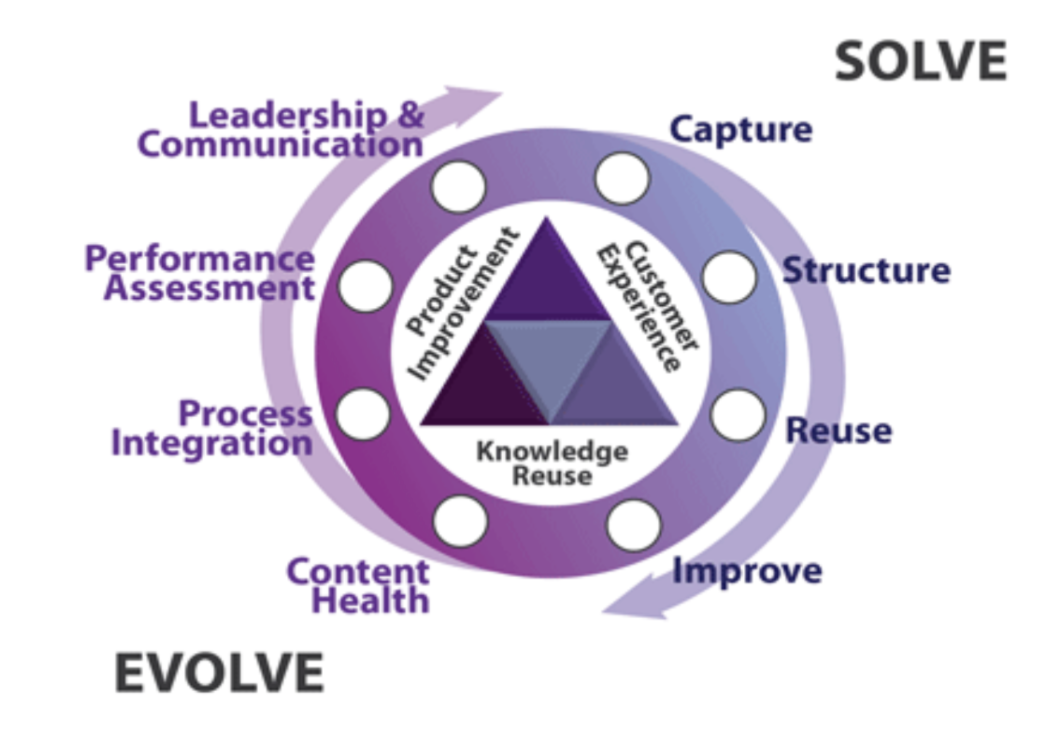What does knowledge management have to do with it?
May 26 · 9 min read

Knowledge management is the system that supports and enables knowledge to grow, flow, and create value. Today, many of us are knowledge workers, and the value we provide originates from our minds rather than with our hands. When customers are paying for services that are essentially your organizational know-how, the engagement of your employees is where that value comes from; and it’s where the system you design with processes and measurement can either add value or take it away. When organizations provide a vision, and design systems to enable their employees to grow through training and exposure to new ideas, a positive customer experience follows.
Knowledge management isn’t about simply constructing a knowledge base and expecting people to use it; it must become a way of being and doing. Continual exposure to the knowledge of others is how knowledge workers grow and how new ideas are formed. Knowledge management doesn’t just make the job easier and result in a better employee experience; it’s becoming a strategic imperative for businesses to continue to deliver value.
A common factor in IT service environments is the high rate of churn for service desk staff. It’s often a high-pressure role with a pressing volume of cases and the persistent threat of service-level agreement (SLA) breaches. A new team member must learn the culture, the services, and the supporting technology before they can confidently provide support. It can take several months to learn all of that, and it’s even harder in a complex pressure-cooker environment. Thoughtful knowledge management, where the organization’s knowledge base is kept current and useful through routine practices and behaviors, aims to reduce that time to proficiency and enable team members to be productive in a quarter of the time. A good knowledge base can be effective just-in-time training, reducing both the stress on new people and the cost of hiring and training.
Knowledge-Centered Service (KCS®) has emerged as a best practice methodology to move knowledge around an organization within a framework that promotes greater employee engagement and delivers value to customers. As the name implies, KCS brings knowledge into focus as the central component for getting work done. Knowledge workers capture, reuse, and improve knowledge while they interact with customers, and they capture, reuse, and improve knowledge when they collaborate with other teams.
While it’s easy to understand in principle, KCS is rarely easy to enact. It’s a collaborative act with many moving parts that can be hard to point in the same direction. Not least because it means influencing people and guiding a large group to follow a common path. Fortunately, KCS has been continually tried by the industry and refined by its creators, the Consortium for Service InnovationTM, since 1992. KCS-certified practitioners know what works and what doesn’t, and they learn more from every participating organization.
KCS is a double-loop model that seeks to:
- Create knowledge as a byproduct of solving problems and answering questions.
- Develop a knowledge base of collective experience.
- Improve the content over time based on demand and usage.
- Foster knowledge sharing and collaboration.
One loop—the Solve Loop—focuses on the knowledge sharing activities that happen in the workflow, and the second loop—the Evolve Loop—ensures the continuing improvement and commitment to the knowledge management efforts.

Let’s imagine the journey a series of customer issues may take in a shared services example. One customer has been granted access to an application on the desktop, but it doesn’t open when they go to launch it. They contact support and describe the error. At the first step, a knowledge worker searches the knowledge base using the words from the customer’s question. In this case, [the application name] doesn’t open.
If no suitable answers are found, the team member captures any knowledge that has emerged from the interaction with their customer—the operating system version, configuration item details, the error message, and the resolution—into a knowledge article. A predefined, simple template structures it in a way that makes the article findable in the knowledge base. If the knowledge worker does find an answer, they review its quality and accuracy. If it’s clear and correct, the article with the resolution is linked with the case record and provided to the customer. When an article needs to be corrected or updated, the knowledge worker flags it with a comment or fixes it on the spot.
In a related case, a different customer experiences the same error and uses the self-service knowledge base to find a solution. Fortunately, when they search for [application name] not launching, a relevant solution immediately presents itself thanks to the issue being known and that team member creating a knowledge article from the first incident.
That example demonstrates the knowledge management activity taking place in the Solve Loop. Let’s go further to see what happens when the Evolve Loop practice, Content Health, is applied. Some analysis of our example service desk activity shows the article being linked a number of times to recent incidents. A knowledge manager decides to provide some proactive content to customers and adds that article to a browsable FAQ on the self-service portal, as well as raising attention to this repetitive issue with a problem manager or subject matter expert. The action helps customers before they’ve had to go searching or opening a case, and more than that, we hope the next step would be root cause removal!
In a customer service environment, the knowledge article often begins as a case record, which is then converted and edited to become an article in the knowledge base once the case is closed. With minimal effort, articles can be published to self-service, removing the repetition from the service workload and enabling customers to help themselves. When teams work together in this way, where knowledge is integrated into the workflow, it’s easy to imagine a future where individual knowledge flows, organizational know-how grows, and value is continually delivered without additional operational cost. Customers are more productive more quickly, and employees are exposed to new knowledge, which makes work more interesting.
Mechanisms for improving the employee experience exist throughout KCS. The Solve Loop removes repetition and increases access to knowledge, unlocking time to work on new issues and projects. The Evolve Loop provides employees with the ability to grow their expertise with the model itself and to develop coaching and authoring capabilities, which have become critical skills for knowledge workers in modern customer service organizations. Whether the knowledge worker can improve or publish a knowledge article or not is part of the KCS journey from beginner to an expert publisher. Depending on how managers reward and recognize the progression of their teams through those stages, employees develop a pride in the contribution their knowledge work has to the customer’s success and the organization’s strategic outcomes. The result can be a highly engaged team of employees who stay longer, know more, and can deliver increasing success for customers and for the whole business.
Adopting a knowledge-centered approach that can sustain changes in priorities, technologies, and even people requires support and advocacy at the executive levels. Processes can change and platforms can be reconfigured for improved knowledge flows, but without the influence and reinforcement of executive and senior leadership, KCS is doomed to limp along and die off. Fortunately, the connection between knowledge management and strategic outcomes is getting easier to draw because increased customer satisfaction is often a key measure and an upgraded employee experience is a byproduct. Leaders who struggle to get the support they need from their board and senior management can now point to an international standard for knowledge management. ISO 30401 provides a language for company directors to engage with knowledge leaders on updating controls for a knowledge-centric organization and a framework for increasing awareness and role modeling.
The explanation of KCS here merely scratches the surface. KCS is a significant change in the way work is done for many organizations, but there are always small actions that can be taken straight away. Small steps taken consistently build habits with lasting impacts.
1. Change your mindset
Start changing the way you think of the governance of knowledge from controls and limitations to guardrails and enablement. The controls are still there, but they’re embodied in the journey of developing KCS competency and growth.
2. Start capturing knowledge now
Provide a simple template and require case notes that capture the issue described in the words the customer used, a field for details of the environment related to the issue, and a space for the resolution. Well-structured case notes can more easily be reused as content for knowledge articles.
3. Search comes first, not last
The value of a collective knowledge resource is only realized when people actively engage with it. Search first, improve, and reuse what exists before solving any problem or starting a new article.
4. Knowledge is a team sport
Being knowledge-centered means developing a shared ownership of the health of the knowledge base. The next person to reuse a knowledge article is responsible for its quality and accuracy. Shared ownership means shared measures. Consider your KPIs today. Do they measure the individual actions over the collective behaviors of the team?
The methodology of KCS is very much a system-wide approach to knowledge flow. Improved employee experience comes through a reduction in repetitive problem-solving, and increased exposure to knowledge and new ideas, which promotes growth in expertise. Better knowledge flows unlock time for employees to work on new challenges and provide value to customers through innovative solutions and a quicker return to productivity. Connecting those everyday actions teams take with their knowledge to the company vision and values is how leaders can turn knowledge management into the way work is done. Consistently reinforce the purpose of being knowledge-centered and share the impact teams have on strategic goals, and a positive employee experience is inevitable.
